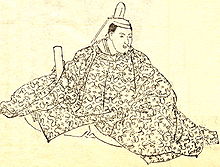- Fujiwara Sadaie
-
Fujiwara no Teika
Fujiwara no Teika (japonais: 藤原定家), aussi connu sous les noms de Fujiwara no Sadaie ou Sada-ie [1] [2], (1162 – 26 septembre 1241) est un poète japonais de waka, critique [3], calligraphiste, romancier [4], anthologiste, scribe [5], et érudit vers la fin de l'époque de Heian et le début de l'époque de Kamakura. Son influence était énorme et à ce jour, on le compte comme l'un des plus grands [6] poètes japonais et peut-être le plus grand maître de la forme waka.
Il a tenu son journal intime, le Meigetsuki (litt. « journal de la pleine Lune ») durant plus de 50 ans, de 1180 à 1235.
Notes
- ↑ "Sadaie" est une lecture sémanrtique alternative du kanji 定家; "...there is the further problem, the rendition of the name in romanized form. Teika probably referred to himself as Sadaie, and his father probably called himself Toshinari, but the Sino-Japanese versions of their names were used by their contemporaries, and this practice is still observed." p. 681-692, note 2 de Seeds in the Heart: Japanese Literature from Earliest Times to the Late Sixteenth Century, Donald Keene. 1999, Columbia University Press, ISBN 0-231-11441-9
- ↑ p. 147 of Woman poets of Japan, 1977, Kenneth Rexroth, Ikuko Atsumi, ISBN 0-8112-0820-6; précédemment publié sous The Burning Heart par The Seabury Press.
- ↑ "The high quality of poetic theory (karon) in this age depends chiefly upon the poetic writings of Fujiwara Shunzei and his son Teika. The other theorists of tanka writing, stimulated by father and son either to agreement or disagreement, contributed also toward the high level of poetic theory, but we may say that Shunzei and Teika were most representative of the age." Cette citation est de Odagiri Hideo, p. 10 de son "Nihon ni okeru bungei hyōron no seiritsu" (The Rise of Art Criticism in Japan), publié par Geijutsuron-shū ("Collection of Discussions of Art"), Tokyo 1962 ; voir la revue de Shun'ichi H. Takayanagi de Japanese Court Poetry par Robert H. Brower et Earl Miner dans Monumenta Nipponica, Vol. 18, No. 1/4. (1963), p. 352-364. [1]
- ↑ On croit que Teika a écrit les Matsura monogatari.
- ↑ "During his last years Teika seems to have composed little poetry, but he was otherwise engaged in copying manuscripts, especially of the major works of Heian literature. It is not much of an exaggeration to say that what we know of the literature of Teika's day and earlier is mainly what he thought was worthy of preservation" p. 673-674 de Seeds in the Heart.
- ↑ "The single most influential figure in the history of Japanese classical poetry, Fujiwara Teika (or Sadaie) 1162-1241, was the supreme arbiter of poetry in his day, and for centuries after his death was held in religious veneration by waka and renga poets alike." Robert H. Brower. Monumenta Nipponica, Vol. 40, No. 4. (Winter, 1985), p. 399-425. [2].
- Charles Murray, dans son Human Accomplishment, donne à Teika la 17e position parmi les personnalités les plus influentes de la littérature japonaise, selon son analyse de la recherche académique dans ce domaine. "Fujiwara no Teika....is one of the four greatest Japanese poets. The son of Shunzei, Teika lived to an advanced age constantly plagued by both recurring illness and reverses and advances in his family's fortunes. Similarly, his poetry and critical writings also underwent a series of changes in the course of his life, leaving behind the most substantial and intense poetic legacy by a single poet in Japanese history."[3]
- "Teika's unique reputation rested in part upon his accomplishment as the leading figure among the many fine poets of the Shinkokin Jidai, the period of fifty-odd years in the late twelfth and early thirteenth centuries when revival and innovation in the native poetry were exemplified in Shin Kokinshū, c. 1204, the eighth, and in many respects the greatest, of the imperially sponsored anthologies of classical verse. As one of the six compilers of the anthology, and with forty-six of his poems included in it, Teika stood at the forefront of the younger and more innovative poets of his day, and his various experiments with diction, rhetoric, and figurative language, as well as with new styles, modes, and aesthetic effects, were widely imitated by his contemporaries. After his death, his quarreling descendants were recognized as the ultimate authorities on all poetic matters, and through them Teika's influence pervaded six hundred years of Japanese poetic history." Extrait de "Fujiwara Teika's Maigetsusho" par Robert H. Brower, Monumenta Nipponica, Vol. 40, No. 4. (Winter, 1985), p. 399-425.
- Donald Keene écrit : "...is the diary of Fujiwara Teika (1162-1241), a man equally celebrated as poet, critic, and editor." p. 95, Keene 1989
- Portail du Japon
- Portail de la poésie
Catégories : Poète japonais | Naissance en 1162 | Décès en 1241
Wikimedia Foundation. 2010.

